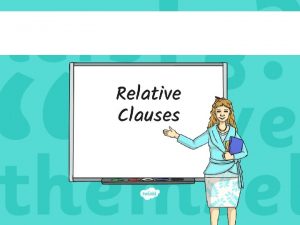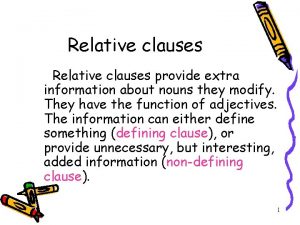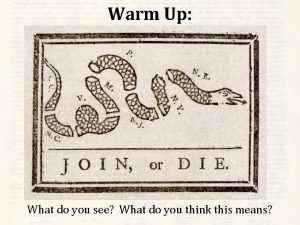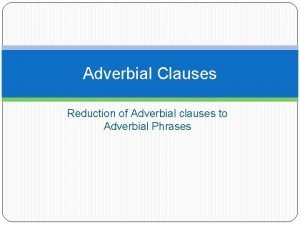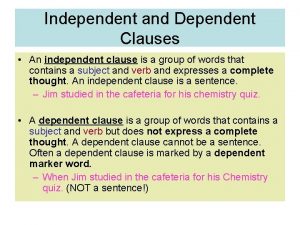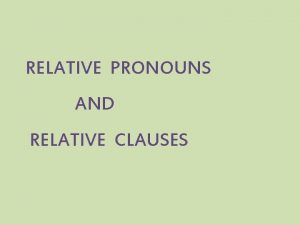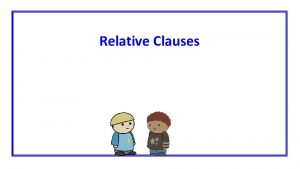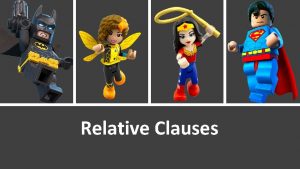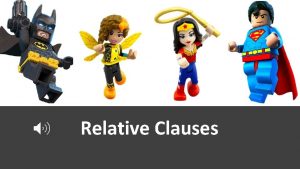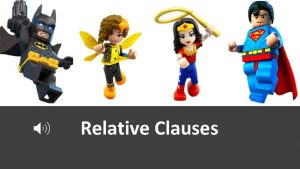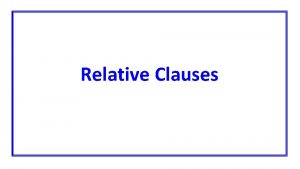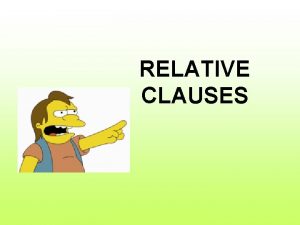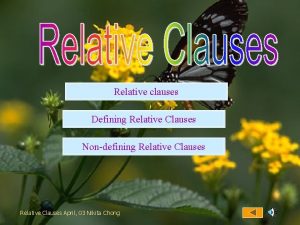Relative Clauses The Rules Relative clauses give extra










- Slides: 10


Relative Clauses: The Rules Relative clauses give extra information related to a previously mentioned noun or pronoun within a sentence. A relative clause always starts with a relative pronoun. Jess was going to a fancy dress party. She was dressed as Batman. The second sentence adds some extra information about the noun in the first sentence so we can turn it into a relative clause, like this. . . Jess, who was dressed as Batman, was going to a fancy dress party. Who is a relative pronoun so this clause of extra information is called a relative clause. As this is extra, non-essential (non-restrictive) information we put the clause in commas.

Relative Clauses: The Rules A relative clause almost always starts with a relative pronoun. Other relative pronouns are: that whom whose which

Relative Clauses: The Rules Where in a sentence? In all of the sentences we’ve looked at so far, the relative clauses have always been in the middle of the main clause e. g. 25 Maple Street, which has been up for sale for years, is apparently haunted. A ghost, whose name is Mr. Stonegarden, roams the corridors. The estate agent, who badly needs a sale, is frightened to show people around. They were all embedded* inside the main clause. Therefore, we could also call them embedded relative clauses. However, relative clauses don’t always have to be embedded. . . *in the middle of

Relative Clauses: The Rules Where in a sentence? Look at this sentence. Where is the relative clause now? How do you know? The children all did well in the spelling test, which made their teacher smile. Which is the relative pronoun so this time the relative clause is after the main clause. We still need a comma before the relative clause as this is also extra, non-essential (non-restrictive) information.

Relative Clauses: The Tricky Bits Relative clauses can be non-restrictive (not essential to the meaning of the sentence) or restrictive (essential to the meaning of the sentence). Here is a restrictive relative clause. . . The book that I bought yesterday cost me five pounds. That is a relative pronoun so this is a relative clause. This time the information in the extra clause is essential (restrictive) to the meaning of the sentence so therefore we don’t need to use commas. Here’s another example of a restrictive relative clause: The distraught teacher threw the test papers that were full of mistakes up in the air.

Quiz! Part 1 Tick two boxes to show which of the words in the sentence below are relative pronouns. The plumber, who arrived late, had forgotten to bring his plunger, which meant he was unable to unblock our sink.

Quiz! Part 2 Read these two sentences. Rewrite them as one sentence, which contains an embedded relative clause. Tawny owls eat mice and other small mammals. Tawny owls are nocturnal birds. Tawny owls, which are nocturnal birds, eat mice and other small mammals. or Tawny owls, which eat mice and other small mammals, are nocturnal birds.

Quiz! Part 3 Place commas in the following sentences in the correct positions to demarcate the relative clauses. Leo, who is very sporty, enjoys PE lessons. The pet ambulance rushed to the injured dog, which had trapped its paw.

 Relative clause extra information
Relative clause extra information Relative clauses and relative pronouns stage 15
Relative clauses and relative pronouns stage 15 The person who phoned me last night is my teacher
The person who phoned me last night is my teacher Extra information clauses
Extra information clauses Relative clause with extra information
Relative clause with extra information What is the main idea of give me liberty or give me death
What is the main idea of give me liberty or give me death Restrictive clause
Restrictive clause Adverbial clause
Adverbial clause Independent main clause
Independent main clause Suitable relative pronoun
Suitable relative pronoun Vztan
Vztan



